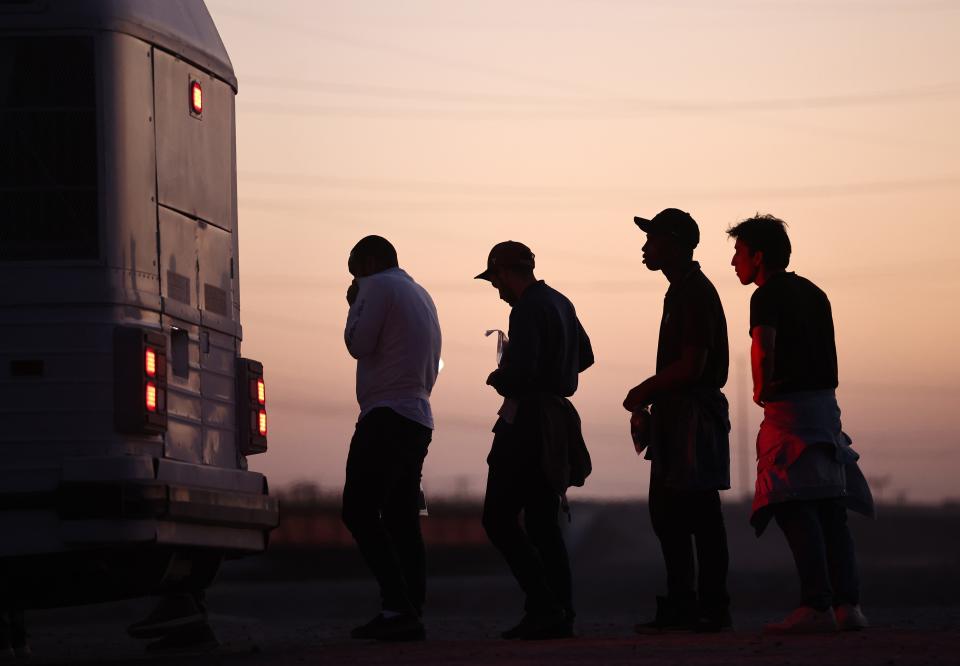What's going on at the US-Mexico border, and what are asylum and parole? Here are answers to key questions

With immigration a top issue heading into the 2024 election, politicians have been speaking often about the challenges at the southern border.
The stunning collapse of a bipartisan border security bill after months of negotiations between Republicans and Democrats was the latest chapter in the national political saga.
The heated conversation over immigration often includes inaccuracies. For instance, a PolitiFact analysis in 2022 of a claim from U.S. Rep. Glenn Grothman found his representation of a border apprehensions statistic to be misleading.
To clear up common areas of confusion, we dived into the influx of migrants at the U.S.-Mexico border, and how the country found itself in this position. Plus: what do policies such as asylum and Title 42 look like in practice?
Here's a guide to help you understand the debate.
More: Ron Johnson and other Republicans pushed for tougher border security. Then they tanked a deal
How many encounters with migrants did U.S. Customs and Border Protection agents have in the last fiscal year at the southern border?
Agents encountered migrants at the southern border about 2,476,000 times in the 2023 fiscal year, which ran from October 2022 through September 2023, according to CBP data.
That number includes people who tried to cross the border more than once. It also includes people who sought out border agents to claim asylum, and those who scheduled appointments to claim asylum at official ports of entry.
Encounters include both the cases where someone is apprehended or detained temporarily, then released into the U.S. with a future court date, and people who are turned away.
The peak month was September, when agents encountered migrants nearly 270,000 times.
But the 2024 fiscal year has even topped that number. In December, the most recent month with available data, agents encountered migrants over 302,000 times.
Poor economic conditions, violence and instability in migrants' home countries often push them to leave, and the appeal of a better life in the U.S. prompts people to embark on dangerous journeys to cross the border.
Another reason for higher encounters is improved detection efforts by border agencies, according to a report from the National Immigration Forum, an advocacy group.
"As border security improves and becomes more effective, the total number of encounters are likely to rise as well," the report said.
How do last year's encounters at the southern border compare to prior years?
Customs and Border Protection data shows agents have encountered people more times in the 2023 fiscal year than in previous years.
In 2022, CBP recorded 2,379,000 encounters. In 2021, there were 1,735,000 encounters.
More: In Whitewater, an influx of immigrants has leaders determined to welcome newcomers, solve problems

Now that Title 42 has ended, what happens to asylum seekers?
Under the pandemic-era Title 42, most migrants were sent back over the border and denied the right to seek asylum. U.S. officials turned away migrants more than 2.8 million times.
But there were no real consequences when someone illegally crossed the border. So migrants were able to try again and again to cross, on the off chance they would get into the U.S. That's one of the common errors, equating encounters with actual people. Indeed, the more people turned away consistently, the more this measuring stick can balloon as they try a second, third or fourth time.
President Joe Biden ended Title 42 in May 2023. Now in place is Title 8, a set of longstanding immigration laws in the U.S. Code.
U.S. law states that people have a right to claim asylum if they arrive at a border and express a "well-grounded fear of persecution."
Border agents give a brief screening to people who say they fear returning to their home country.
"If you say, 'I have a fear of return,' it triggers a protection under our laws that ensures that a government official will review your case to see if you are likely to be successful with qualifying for asylum in the U.S.," said Erin Barbato, director of the Immigrant Justice Clinic at the University of Wisconsin.
If a migrant passes the initial screening, their case then goes to the immigration court system to determine if they can stay in the U.S., but that process can take years. Usually they are released into the U.S. to wait out their cases because Border Patrol stations don't have the capacity to detain everyone.
These are generally "defensive asylum" cases, where people are placed in removal proceedings and must prove they should stay in the U.S. If an asylum seeker loses the case, they face deportation.
Asylum seekers with a court date have an incentive to go to their hearings because if they don't show up, they will be ordered deported, Barbato said.
How long do migrants wait for asylum court hearings?
The asylum system is massively backlogged, with over 1.1 million pending cases. Petitioners are waiting an average of nearly four years, according to the Transactional Records Access Clearinghouse, or TRAC, at Syracuse University.
But going through process is not a sure way to stay in the U.S. About 50% of asylum claims in the last fiscal year were denied, according to TRAC data.
While they wait for their court dates, asylum seekers can apply for work permits.

What is parole and how is it being used?
One point of debate during border bill negotiations in the Senate was humanitarian parole. That is the president's authority to allow migrants into the U.S. for special cases during emergencies or global unrest. It does not provide a path toward U.S. citizenship.
Biden's administration has relied heavily on humanitarian parole. The U.S. airlifted nearly 80,000 Afghans and brought them to the U.S. after the Taliban takeover. The U.S. has admitted tens of thousands of Ukrainians who fled after the Russian invasion.
Last year the administration announced a plan to admit 30,000 people a month from Cuba, Haiti, Nicaragua and Venezuela via parole, provided those migrants had a financial sponsor and flew to the U.S. instead of going to the U.S.-Mexico border for entry.
Also being admitted into the U.S. through the parole authority: Migrants who make appointments through the CBP One phone app and are processed at official ports of entry.
What is the CBP One app?
The Biden administration wants more people to be processed at these official border crossings instead of crossing unlawfully between ports. So, the administration has tried to encourage migrants in Mexico to schedule appointments through the CBP One app.
There is an incentive for those who use the app and cross lawfully: a fast-track to legal work authorization.
Glitches and challenges with the app are well-documented. Many people try every morning to get an appointment in the lottery system. About 1,450 appointment slots are available each day.
CBS News reported that in the app's first year, 450,000 migrants were allowed into the U.S. with the process. Migrants made more than 64.3 million requests to enter the country using the app, the outlet reported.
Those who do book an appointment have a brief meeting with a border agent and, if they pass certain safety checks, are released into the U.S. with a notice to appear in court at a certain date. They could go through the asylum process at a later point.
"Most people, after that interview, are allowed to live in the United States, but they are in deportation proceedings. So they receive that Notice to Appear, and they also have to have a sponsor in the U.S.," Barbato said.
What are 'got-aways,' and how many are entering the U.S.?
Several Republican politicians have expressed concern about so-called "got-aways," or people who crossed the border into the U.S. without being stopped by border agents.
It is difficult to know exactly how many people entered without being inspected, but the Department of Homeland Security creates an estimate based on models and observations. For example, an agent may see someone in the distance but can't reach them, or a sensor or surveillance tool detects that someone is crossing.
The Congressional Budget Office used DHS officials' public statements about got-aways to make its own estimate of 860,000 people in the 2023 fiscal year.
Republicans have argued that people who cross undetected pose a security threat. Laurence Benenson, vice president of policy and advocacy at the National Immigration Forum, agrees that the government can do better at getting control over the border, and that it's important to know who is crossing into the country.
But Benenson also believes that most of the people who cross undetected are coming to the U.S. for the same reasons as those who encounter border agents.
"They come here for a better life, they come here to escape persecution, they come here to work and be with their families," he said.
The Associated Press contributed to this report.
Sources
U.S. Customs and Border Protection, “Nationwide Encounters,” Jan. 29, 2024
National Immigration Forum, “What Makes a Border Secure? Building a Healthier Border Dialogue,” Aug. 16, 2022
Phone call with Erin Barbato, Jan. 29, 2024
Phone call with Laurence Benenson, Jan. 26, 2024
Associated Press, “Title 42 has ended. Here’s what it did, and how US immigration policy is changing,” May 12, 2023
Transactional Records Access Clearinghouse, “Immigration Court Asylum Backlog,” Feb. 13, 2024
Transactional Records Access Clearinghouse, “Asylum Decisions,” Feb. 13, 2024
Associated Press, “A last sticking point in border security negotiations is humanitarian parole. Here’s what that means,” Jan. 18, 2024
CBS News, “Migrants in Mexico have used CBP One app 64 million times to request entry into U.S.,” Feb. 12, 2024
Congressional Budget Office, “The Demographic Outlook: 2024 to 2054,” Jan. 24, 2023
This article originally appeared on Milwaukee Journal Sentinel: Asylum, parole, got-aways, migrant encounters: What border terms mean
Solve the daily Crossword

